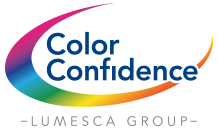What are colour guides and why do I need them?
Colour guides are a vital tool for any designer, as they not only help you discover the perfect colour but they also ensure that your colour remains consistent. Colour guides allow you to speak in a universal language to ensure that the specific shade of blue you’ve chosen is understood by your team or client.
Whether you design architecture, fashion, interiors or graphic design, it’s important to get the guide that best suits your needs, as not one colour guide fits all. We’ve broken down our advice and recommendations to help you find the guide that you suits you and your work best.
Which colour guides do I need?

 NCS, or Natural Colour System, is the ideal guide for designers working in architecture, paint and production. This system is designed to describe colours as the human eye sees them. It breaks colour down into hue and nuance and makes it easy for designers to establish which exact shade they need for painting exterior buildings.
NCS, or Natural Colour System, is the ideal guide for designers working in architecture, paint and production. This system is designed to describe colours as the human eye sees them. It breaks colour down into hue and nuance and makes it easy for designers to establish which exact shade they need for painting exterior buildings.
The first company to standardise colours in Germany, RAL is another guide that, like NCS, is suitable for designers working in architecture and paint. The RAL colour charts allow you to select and verify colours at international standards. RAL charts work off a simple 4-digit code system to make selecting colours easy and definitive.
For designers working in print, DCS is a great resource for FOGRA-certified colour checking and verification. Ideal for printing projects of any kind, DCS guides offer a broad and easy-to-use range, including a suite of reference books printed on key substrates. Colour check charts and high precision measurement tools are also available, including Typometers and Lithometers for accurate colour throughout your work.
If your work is more centred around graphic design, then you will benefit from the Pantone Colour Guides. With colour being one of the most important elements in product development, branding and digital design, it is vital that you not only find the right colour but that it translates across the board.
For confident colour management across different platforms, the Pantone Color Bridge guides are the ultimate tool when designing on and offline. These guides allow designers to view the same spot colour next to their closet industry-standard CMYK equivalent, and convert HTML and RGB with the value equivalents for digital design applications.
When you’re creating digital designs there are even more factors that can affect how the human eye sees colour on screen. It isn’t news to any graphic designer that the same colour can look completely different depending on what screen you’re looking at, or in which room or even when viewing designs on a mobile or tablet device on the go. This difference can be subtle or very obvious, but by using Pantone Colour Guides, you can be confident that the final design (whether printed or displayed in the digital world) is the exact colour you or your client has selected.
There are several different Pantone Colour Guides available, including some that are specifically created for working with for metallics, pastels or even neon shades. 
 When designing fashion products, Pantone offer their Fashion, Home & Interiors range, which is made up of market-driven colours created for hard home, ceramics, textiles, paint, cosmetics, fashion accessories and leather goods. As with any colour-based design, it is so crucial to be on the same page with clients and your team before the final design goes into production.
When designing fashion products, Pantone offer their Fashion, Home & Interiors range, which is made up of market-driven colours created for hard home, ceramics, textiles, paint, cosmetics, fashion accessories and leather goods. As with any colour-based design, it is so crucial to be on the same page with clients and your team before the final design goes into production.
Pantone’s 2,625 FHI colours are available in cotton, polyester and as pigment on paper. You can choose from a multitude of formats, ranging from fan decks, cotton chips and swatches, and even individual polyester and nylon swatches. All Pantone FHI colours on cotton are also available as lacquered coating, so you can match your textiles to coated buttons, zippers, trimmings, and accessories. Also great for leather! The most popular FHI colours are also available in plastics.
If you would like more guidance on which colour guide is the right one for you, feel free to speak to our team of experts. You can read more about why colour standards are important here.




